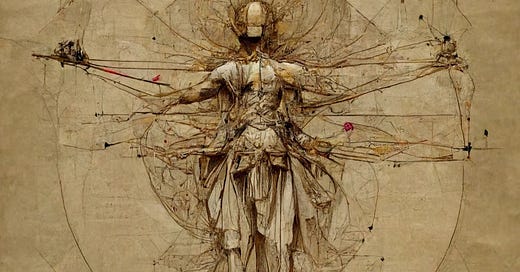
A note: Today’s episode brings the third season of The Culture Journalist to a close. We’re about to take a short break from releasing new episodes, but our work doesn’t stop: We’ll be hard at work prepping the next season, along with subscriber-only goodies like essays, our monthly list of culture recommendations, and playlists.
You can expect a few missives from us in your inbox in the meantime. But we wanted to take this moment to remind you that this podcast continues to be an entirely independent project. To keep making it possible, sign up for a paid subscription.
Hey friends. You’ve probably noticed that the art for this Substack has been a bit… surreal lately. For the past few months, we’ve been experimenting with Midjourney, an AI image generation tool and Discord bot that pulls visual data from all over the internet to generate original art images from random combinations of words. If you’re so inclined, you can even choose to render these images in the style of one of the artists whose paintings you had to memorize in Art History 101.
For our episode with Mark Redito, one of the musicians behind a 77-person “headless” band called Chaos, we gave Midjourney the prompt: “Headless chaos in the style of Giorgio de Chirico.” After some trial and error, it spat out an image of a caped, headless figure that looked, well, kind of like it had been painted by Giorgio de Chirico.

For Emilie’s recent essay about the decline of scene culture during the pandemic, we used the prompt: “Post-pandemic hipsters in the style of Salvador Dalí” — with predictably ridiculous results.

If you spend just a few minutes in the Midjourney Discord, it’s not hard to see why hundreds of thousands of people have fallen down the same rabbit hole we have since the project moved into open beta in July. Especially if you aren’t a trained artist, the ability to use words to give life to an image or idea in your head — or create a delightfully strange approximation of it — is nothing short of magical.
Midjourney isn’t the only research laboratory making tools with the potential to democratize visual image generation in this way: Unless you’ve been living under a rock this year, you’ve probably heard of DALL-E 2, a machine-learning model from AI research giant Open AI that takes a slightly different, more photorealistic approach to summoning novel images from the internet ether. DALL-E 2 has an amazing feature that allows you to explore what an image would look like — and even a famous painting like A Girl with a Pearl Earring — if you extended it beyond the frame. Separately, it’s already responsible for some of this year’s dumbest memes, like the “pugachu”: a combination of a pug and a Pikachu.
But, like all technological and creative disruptions, these tools raise big existential questions and concerns. We just told you about how we used Midjourney to create images in the style of de Chirico and Dalí, then used said images as artwork on our Substack, a project that makes its money from paid subscriptions. Those artists are no longer living. But these machine learning models source training data from all over the internet — what if we started making art in the style of a living artist, without compensating them for their work or even asking for their consent?
It’s no surprise that tools like DALL-E 2, Midjourney, and open-source text-to-image model Stable Diffusion are creating something of a moral panic in the worlds of art, media, and design. Graphic designers and other commercial artists are worried that AI will spur companies to replace human labor with machines while exacerbating the scourge of intellectual property theft that they’ve already been dealing with on the internet for years. A photo editor at New York magazine recently penned an essay asking whether DALL-E 2 was going to put her out of a job. Which all raises the question: Is AI the beginning of a more egalitarian artistic future, or the terrifying final stage of a trajectory where corporations and developers find increasingly insidious ways to extract value from the creative class?
To begin to make sense of the economic, ethical, and artistic implications of these tools, we brought on the artist, technologist, and Interdependence co-host Mat Dryhurst. You might remember him from our episode last year on NFTs and their implications for the future of independent music.
Mat and his partner, the composer Holly Herndon, have been diving headfirst into the possibilities and pitfalls posed by AI for several years now. Most recently, they teamed up with Wolf Bear Studio’s Jordan Meyer and Patrick Hoepner to launch Spawning, an organization building tools by and for artists working with AI. The idea is to give artists greater control over their AI training data by allowing them to opt in or out of these data sets, set permissions on how their style and likeness is used, and even offer their own models to the public. The goal, Mat says, is to establish a standard of consent honored by AI research companies as the tech — whether we like it or not — barrels into the future.
Mat joins us from Berlin to give a crash course in the history of text-based image generation and the specific technological developments that led to this moment — from grassroots Discord groups, to Amazon, Microsoft, and Elon Musk-funded behemoths like Open AI, to the nation-states incentivizing this growing research field on the geopolitical stage.
We discuss the possibilities and limitations of these tools as a medium for creative expression, the parallels between this moment and the advent of photography, and the changing nature of art, and perceptions of artistic value, in a world where people can create striking images at the push of a button. Finally, we get into the steps we can take now to avoid this becoming a nightmare scenario for artists — or, for the rest of us, the start of an era of really terrible art.
Read Holly and Mat’s essay, “Infinite images and the latent camera”
Follow Mat on Twitter
Learn more about Spawning
Use Spawning’s new tool, Have I Been Trained?, to see if your work or likeness is being used as AI training data
Subscribe to Mat and Holly’s podcast, Interdependence
















Share this post